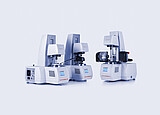Accessory for MCR:
Rheo-SALS
- Accessory for “Structure Analysis and Rheo-Optics”
- Small-angle light scattering (SALS) combined with rheology
- For investigating shear-dependent shape and orientation of microstructure
- Temperature range from -20 °C to 300 °C
The combination of optical with rheological measurements is essential to understand the dependencies between the microstructure and the mechanical properties of complex fluids. Shear-dependent changes in microstructure or crystallization processes during rheological measurements are relevant for multiple applications, such as the production and development of emulsion-, suspension-, or polymer solutions. Small-Angle Light Scattering (SALS) is a well-established technique for structure analysis in the size range of the applied laser's wavelength. The greatest benefit of Rheo-SALS by Anton Paar is its wide scattering angle, allowing structure measurements in a large size range. The combination of SALS measurement and rheological analysis technology provides the most valuable data for research and development.
Key features
Gain structural information simultaneously with rheological data and in real-time
The combination of rheology and small-angle light scattering allows the investigation of shear-dependent structural changes or crystallization by analysis of the laser light's scattering pattern. A primary laser beam is focused on a sheared sample that scatters this light. The resulting scattering patterns visualize structural changes and contain information about the microstructure. In this way it is possible to generate structural information and rheological data simultaneously and in real-time.
All rheological test modes are available with this setup, which can be combined with temperature control systems either based on Peltier (-20 °C to 200 °C) or electrical heating (up to 300 °C). Both temperature systems offer easily exchangeable lower glass plates. A heated bottom plate and a hood that ensures low temperature gradients prevents sample oxidation and makes purging with nitrogen possible. Depending on the sample’s viscosity, a parallel-plate or a double-gap system can be used.

Laser Class 1 for the highest safety
The SALS option is pre-aligned and does not require any major user alignments for minimized installation time and more time for measurements. The measuring systems are swiftly adjusted for parallel-plate and double-gap measurements, and enable quick and reproducible positioning and focusing. The large range of scattering angles allows measurements of both small and large structures. For reduced background noise, the scattered light has to pass a non-moving plate and as there are polarizers before and after the sample, you can measure with polarized as well as with depolarized light. The modular and open design consists of a laser diode, a CCD camera, optics, and polarizers equipped with a laser integrated in the upper module. The laser conforms to the laser Class 1, employing a certified laser safety concept. The optics can be moved independent of the laser for a flexible focus on different points of the sample.

Match your data with images and videos from the integrated CCD camera
The integrated camera automatically records images and videos during the test which is afterwards matched with the rheological data by the rheometer software RheoCompass. Once saved, you can analyze the recorded measurement images or videos at any time. They can be assigned to specific measuring points and in this way directly linked to the rheological data. Both the rheometer and CCD camera are being controlled by the software and the scattering patterns can be further analyzed by using a dedicated software package (including the estimation of particle size distribution). The perfect match of measurement and analysis technology ensures the most valuable data for research and development.

RheoOptics Toolbox - Combine Rheo-SALS with other optical methods for a full-range sample analysis with only one device
The SALS option is part of the modular RheoOptics Toolbox for the MCR rheometer series which also contains other options for structure analysis. Due to the modular MCR rheometer concept you can easily and quickly switch between the SALS option and other optical tools, such as Raman spectroscopy, IR spectroscopy, (fluorescence) light microscopy, Polarized Light Imaging and UV curing. For applying a wide temperature range all these optical tools can be combined with Peltier and electrical temperature devices. Use your rheometer and temperature device with different optical tools and get the most out of your sample with only one device. Besides the optical tools, Anton Paar also offers further accessories for Particle Imaging Velocimetry (PIV), dielectric spectroscopy with the Dielectro-Rheological Device (DRD), Small-Angle X-Ray Scattering (SAXS), and Small-Angle Neutron Scattering (SANS) that can also be easily mounted to your MCR rheometer and open up even more possibilities for structure analysis.

Deeper insights for smart material development
All materials showing significant shear-induced changes in microstructure or shear-dependent crystallization processes are suitable for investigations with Rheo-SALS. Using small-angle light scattering in combination with rheology can, for example, lead to deeper understanding of the stability of an emulsion or the demixing of a polymer blend In general, all samples with inherent microstructure can be measured with this setup, e.g. as a complementary method to rheology combined with a light microscope.
Typical examples for such materials:
- Emulsions (e.g. food products, consumer products)
- Suspensions, colloidal solutions
- Surfactants (e.g. self-assembled micelles)
- Polymer solutions, polymer melts, polymer blends
- Soft matter (e.g. hydrogels for life-science applications)

Anton Paar Certified Service
- More than 350 manufacturer-certified technical experts worldwide
- Qualified support in your local language
- Protection for your investment throughout its lifecycle
- 3-year warranty
Documents
-
Combined rheological methods - From rheo-optics to magneto-rheology and beyond Application Reports
-
Instruments - MCRxx2 Evolution series Brochures
Compatible instruments
Similar products

Accessory for MCR:
Rheo-SANS/SAXS

Accessory for MCR:
Particle Imaging Velocimetry

Accessory for MCR:
Rheo-Microscope

Option for a Rheometer with two EC Drives:
Rheo-Microscopy Setup

Accessory for MCR:
Dielectric Spectrometer

Accessory for MCR:
Polarized Light Imaging

Rheo-Confocal Microscopy:
MCR 702e Space MultiDrive and Rheo-Optics

Optical accessory for MCR:
Rheometer-Infrared Spectrometer Adapter






